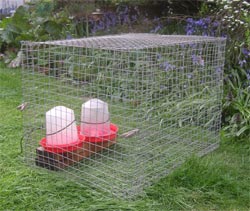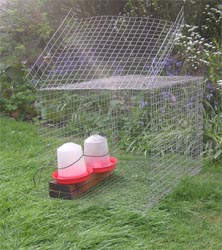How to make a broody coop to stop your chickens and bantams being broody (takes 1 hour to make)
Posted by Fiona Nevile in Chickens | 130 comments “Two of my hens are broody.” Bunty was exasperated.
“Two of my hens are broody.” Bunty was exasperated.
“We’ve got a broody one too.”
This was our first summer of keeping bantams (a small friendly breed of chicken).
Bunty continued, “I wish I hadn’t suggested Bantams. I’ve discovered that they go broody at the drop of a hat.”
Years ago Bunty had kept chickens commercially. Those were a type of chicken bred for laying that rarely go broody.
She thought that she had the answer to our dilemna.
“We need anti broody coops. You’re good at making things. Why don’t you make a couple?”
My heart sank. I thought that they would take hours to make, imagining a sort of dog kennel with a wide gauge wire mesh floor.
To stop a hen being broody you need to stop her from settling comfortably. The trick is to construct a cage with a floor made of large wire mesh ( with at least 1 inches squares). Set the cage on bricks so that the floor is suspended, keeping the bricks to the outside edges so that she can’t sit on them. Provide a small drinking fountain and feeder within the cage and pop her in. She won’t be able to settle on the wire mesh floor and within a few days will get over her broodiness.
I went to bed early and woke at four. In the still cold light I realised that the entire cage could be made of wire mesh. I went to the garden centre after breakfast and bought three sheets of wire mesh measuring 90cm x 60cm. The cage is 60 cm long and 43 cm high and 43 cm wide This allows for an overlap at the joins.
Our broody coop is simple to make. Lay the wire on a flat surface, and bend 2 cm of wire mesh to a 90 degree angle along a 60 cm side. Then lift the opposite end and press it into the angled flap. Press firmly on the bulgy end and fold flat to make a clean angle and pull the ends apart. You now have the floor and one side. Repeat the operation for the roof and the other side.The flap may seem a bit fiddly but it makes the cage much more rigid and stable.
Now attach the the two halves together to make the body of the cage. I tied the two together with twists of wire at 5cm intervals. The front and back of the cage are made from the remaining sheet. Hold the sheet against the opening at the back and cut to fit using wire clippers. The back was attached using wire twists. The front is hinged at the top with sides that bend back a bit over the sides of the cage.
Having a hinge at the top makes it easier to put the chicken in the cage. If you put her in headfirst you can quickly drop the door down and secure it with pegs before she has turned around. We used clothes pegs but small bulldog clips would be good for a larger chicken.

The broody coop in the photo is the mark one version. I made Bunty a Rolls Royce (mark two) cage out of plastic coated wire. Definitely worth the extra investment as it’s stronger and more durable. Carol (our Maran) has never been broody. If she was, I’d make her a bigger cage (the hen needs to be able to stand up). And it would have to be stronger than the mark one cage as she is a much larger bird than the bantams.
Our broody coop sits in the Day Centre. Bunty had hers in the run with a bit of wood as a roof.
It took me a while to realise when the perfect moment of release should take place. The chicken in the broody coop will ask to be released immediately. But bide your time. Her comb will gradually change from pink to red. When it is red she can get out of jail. If you release her while her comb is still pink she will nip back to the nesting box and you will have to start the process all over again.
If you have a broody chicken and you want her to sit on fertilised eggs put a floor on the bottom of the broody coop, fold the door over the roof and you have a quiet area in which she can sit for twenty one days, with easy access to food and water. She needs to be able to move away from the nest so don’t lock her in. Ideally, place the cage somewhere that is protected from the elements. Or construct a simple roof like Bunty did (a bit of plywood slightly bigger than the cage). It’s not a good idea to let a broody hen stay in the nesting box as it puts the other hens off laying eggs.
Leave a reply





Hi, and thanks for this excellent (eggcellent – sorry!) resource.
I have 2 lovely Pekin Bantams and the ‘non-dom’ went broody earlier this month after laying about 2 eggs in total this year. We can always tell by that very annoying ‘clock clock’ sound they make. Unfortunately for her, the other hen gets very irritated when she hogs the nesting box and feather pecks her mercilessly. So we really had to do something for her own sake as she’s starting to look oven ready! I built a broody coop according to your instructions and have installed her in it – I leave it outside during the day so she can stay nice and cool with a plastic bag over the top to offer some shelter and put it in the shed at night. She’s not happy but still ‘clock-ing’ so it may be a few days yet. Have you ever come across a dominant hen pecking her underling when she goes broody? She doesn’t seem to do it at other times.
Thanks!
Hello!
I’ve been reading your excellent advice on broody bantams. I think one of my two (hardly a flock!) Wyandotte’s has suddenly gone broody, she’s been laying really well recently too. Happy to go down the broody coup route but am concerned about doing this whilst its the middle of January with sub-zero temperatures at night. What do you think?
Thank you for any advice.
Simon
Im guessing you leave the broody coop in a shed not out in the garden ?
Hi Sarah
I put our broody coop in a shed but I’ve seen them out in other peoples gardens with a large piece of wood on the top so that there is shelter from rain. I reckon that giving some shelter – ie a shed is the better route myself.
My Orpington bantam hen will feed when I turf her off the next and i shut the coop door so taht she can’t get in the nesting box.
She keeps making a funny chuff chuffing noise and has started pulling the feathers our from around her bottom.
Is this a sign of her being broody.
She is about 1 year old.
Hi Lesley
The clucking means that she is brrody also plucking her own feathers is a sign too.
Thanks. I thought so. Since none of the hens are laying at the moment, I am shutting them all out of the coop into the covered run so that they can’t nest. If is doesn’t work by weekend I will sort out a broody coop. Thanks for your help.
HI
I have two very broody pekins that will not come off the nest.
I am going to make a broody coop like you suggest.
However I live in Lancashire and it still cold at night even though it is May. Would you still keep them outside at night.
Would it work if I let them back in the coop at night with the other hens and then lift them straight back into the BC in the morning ?
Hi Lesley
They have to stay in the broody coop 24/7. Could you put in a garden shed or garage?